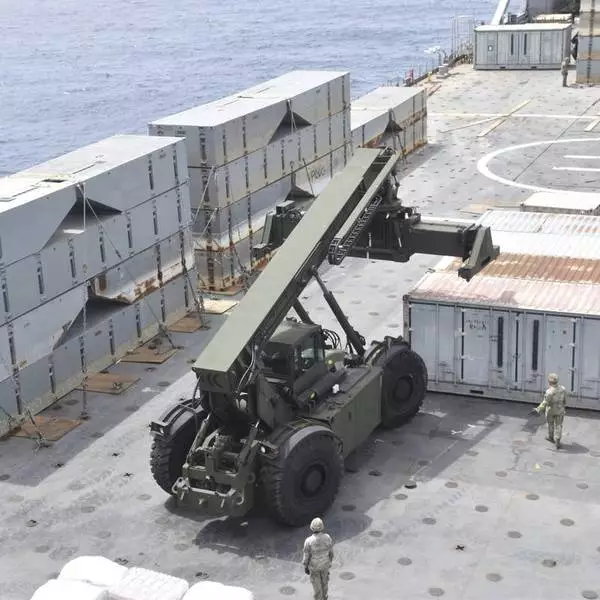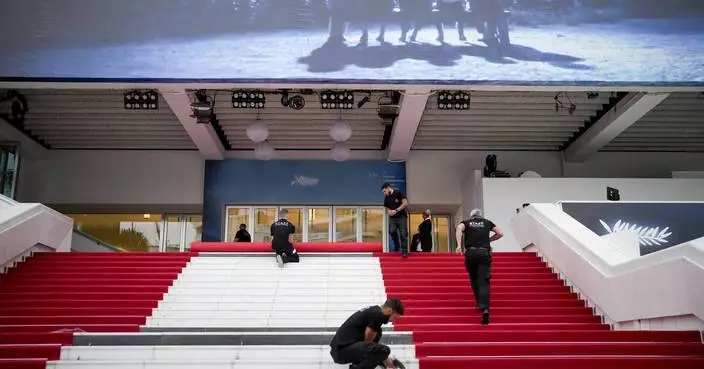Jail personnel moved R. Kelly on Tuesday into the general inmate population despite earlier concerns — apparently shared at one point by the singer — that other inmates could try to hurt him because of his celebrity status or because he is accused of sexually assaulting minors, federal prosecutors in Chicago said in a new court filing.
Word that Kelly has been moved from a restrictive unit at a high-rise jail in downtown Chicago comes days after Kelly's lawyers said the 52-year-old had been held in solitary confinement by no fault of his own since his July arrest, with none of the privileges of other inmates, such as access to TV or candy from the jail commissary, or to outdoor exercise and daily showers. They characterized the conditions as "cruel and unusual punishment."
But in their Tuesday filing in U.S. District Court in Chicago, prosecutors disputed defense suggestions Kelly had been kept in the special housing unit, called the SHU, against his will and for no good reason, alleging Kelly himself had asked after his July arrest on federal charges to be kept from other inmates. From the SHU, Kelly also was able to purchase items from the jail store, "including snacks such as Snickers," the filing says.
Kelly's attorney, Steve Greenberg, said he was pleased his client was no longer in the special housing unit, which Greenberg said also hampered Kelly' preparation for trial.
"But he shouldn't have been there in the first place," he said. "If you are going to arrest high-profile individuals, you should find a way to hold them in a non-draconian way."
Kelly faces 40 counts of sexual various state and federal sexual misconduct charges in Illinois, Minnesota and New York, from child pornography to the aggravated sexual assault. The Grammy Award-winner has entered not guilty pleas in all the cases but the one in Minnesota , where he will be arraigned later.
A status hearing in Kelly's federal case in Chicago is set for Wednesday, where Judge Harry Leinenweber is likely to ask attorneys about Kelly's current jail conditions.
Prosecutors quoted Kelly as saying in a recorded phone call from jail when he was still in the restrictive unit that he was torn about whether he could trust other inmates if transferred to areas where inmates mingle and interact. He said the jail staff told him he could give it a try for a few days.
But "they can't guarantee nothing," Kelly was quoted as telling the other person on the line, who was not identified in the filing. "I was like, hmmm, too many people up on you and I done seen too many movies, you know, and it's just ... I'm so popular here."
Kelly initially had misgivings about being in the general inmate population but quickly changed his mind, Greenberg said. He added that he wasn't overly worried that a fellow inmate might bid to make a name for himself by attacking a celebrity.
"Kelly is still enormously popular, especially in minority communities," Greenberg said. "What kind of a name do you make for yourself by hitting R. Kelly?"
Follow Michael Tarm on Twitter: https://twitter.com/mtarm
WASHINGTON (AP) — The U.S. military finished installing a floating pier for the Gaza Strip on Thursday, with officials poised to begin ferrying badly needed humanitarian aid into the enclave besieged over seven months of intense fighting in the Israel-Hamas war.
The final, overnight construction sets up a complicated delivery process more than two months after U.S. President Joe Biden ordered it to help Palestinians facing starvation as food and other supplies fail to make it in as Israel recently seized the key Rafah border crossing in its push on that southern city on the Egyptian border.
Fraught with logistical, weather and security challenges, the maritime route is designed to bolster the amount of aid getting into the Gaza Strip, but it is not considered a substitute for far cheaper land-based deliveries that aid agencies say are much more sustainable. The boatloads of aid will be deposited at a port facility built by the Israelis just southwest of Gaza City and then distributed by aid groups.
Heavy fighting between Israeli troops and Palestinian militants on the outskirts of Rafah has displaced some 600,000 people, a quarter of Gaza’s population, U.N. officials say. Another 100,000 civilians have fled parts of northern Gaza now that the Israeli military has restarted combat operations there.
Pentagon officials said the fighting in Gaza wasn’t threatening the new shoreline aid distribution area, but they have made it clear that security conditions will be monitored closely and could prompt a shutdown of the maritime route, even just temporarily. Already, the site has been targeted by mortar fire during its construction and Hamas has threatened to target any foreign forces who “occupy” the Gaza Strip.
The “protection of U.S. forces participating is a top priority. And as such, in the last several weeks, the United States and Israel have developed an integrated security plan to protect all the personnel," said Navy Vice Adm. Brad Cooper, a deputy commander at the U.S. military's Central Command. "We are confident in the ability of this security arrangement to protect those involved.”
U.S. troops anchored the pier at 7:40 a.m. local time Thursday, the military's Central Command said, stressing that none of its forces entered the Gaza Strip and would not during the pier's operations.
“Trucks carrying humanitarian assistance are expected to begin moving ashore in the coming days,” the command said. “The United Nations will receive the aid and coordinate its distribution into Gaza.”
The World Food Program will be the U.N. program handling the aid, officials said.
Israeli forces will be in charge of security on the shore, but there are also two U.S. Navy warships near the area in the eastern Mediterranean Sea, the USS Arleigh Burke and the USS Paul Ignatius. Both ships are destroyers equipped with a wide range of weapons and capabilities to protect American troops off shore and allies on the beach.
Israeli military spokesman Lt. Col. Nadav Shoshani confirmed that the pier had been attached and that Israeli engineering units had flattened ground around the area and surfaced roads for trucks.
“We have been working for months on full cooperation with (the U.S. military) on this project, facilitating it, supporting it in any way possible,” Shoshani said. “It’s a top priority in our operation.”
Aid agencies say they are running out of food in southern Gaza and fuel is dwindling, which will force hospitals to shut down critical operations and halt truck deliveries of aid. The U.N. and others have warned for weeks that an Israel assault on Rafah would cripple humanitarian operations and cause a disastrous surge in civilian casualties.
More than 1.4 million Palestinians — half of Gaza’s population — have been sheltering in Rafah, most after fleeing Israel’s offensives elsewhere.
The first cargo ship loaded with 475 pallets of food left Cyprus last week to rendezvous with a U.S. military ship, the Roy P. Benavidez, which is off the coast of Gaza. The pallets of aid on the MV Sagamore were moved onto the Benavidez. The Pentagon said moving the aid between ships was an effort to be ready so it could flow quickly once the pier and the causeway were installed.
The installation of the pier several miles (kilometers) off the coast and of the causeway, which is now anchored to the beach, was delayed for nearly two weeks because of bad weather. The sea conditions made it too dangerous for U.S. and Israeli troops to secure the causeway to the shore, U.S. officials said.
Military leaders have said the deliveries of aid will begin slowly to ensure the system works. They will start with about 90 truckloads of aid a day through the sea route, and that number will quickly grow to about 150 a day. But aid agencies say that isn't enough to avert impending famine in Gaza and must be just one part of a broader Israeli effort to open land corridors.
Because land crossings could bring in all the needed aid if Israeli officials allowed, the U.S.-built pier-and-sea route “is a solution for a problem that doesn’t exist,” said Scott Paul, an associate director of the Oxfam humanitarian organization.
Biden used his State of the Union address on March 7 to order the military to set up a temporary pier off the coast of Gaza, establishing a sea route to deliver food and other aid. Food shipments have been backed up at land crossings amid Israeli restrictions and intensifying fighting.
Under the new sea route, humanitarian aid is dropped off in Cyprus where it will undergo inspection and security checks at Larnaca port. It is then loaded onto ships — mainly commercial vessels — and taken about 200 miles (320 kilometers) to the large floating pier built by the U.S. military off the Gaza coast.
There, the pallets are transferred onto trucks, driven onto smaller Army boats and then shuttled several miles (kilometers) to the floating causeway, which has been anchored onto the beach by the Israeli military. The trucks, which are being driven by personnel from another country, will go down the causeway into a secure area on land where they will drop off the aid and immediately turn around and return to the boats.
Aid groups will collect the supplies for distribution on shore, with the U.N. working with the U.S. Agency for International Development to set up the logistics hub on the beach.
Sabrina Singh, Pentagon spokeswoman, told reporters that the project will cost at least $320 million, including the transportation of the equipment and pier sections from the United States to the coast of Gaza, as well as the construction and aid delivery operations.
Associated Press writers Jon Gambrell in Dubai, United Arab Emirates, and Julia Frankel in Tel Aviv, Israel, contributed to this report.

US military says Gaza Strip pier project is completed, aid to soon flow as Israel-Hamas war rages on

US military says Gaza Strip pier project is completed, aid to soon flow as Israel-Hamas war rages on

In this image provided by the U.S. Army, soldiers assigned to the 7th Transportation Brigade (Expeditionary) and sailors attached to the MV Roy P. Benavidez assemble the Roll-On, Roll-Off Distribution Facility (RRDF), or floating pier, off the shore of Gaza on April 26, 2024. The U.S. expects to have on-the-ground arrangements in Gaza ready for humanitarian workers to start delivering aid this month via a new U.S.-backed sea route for Gaza aid. An official with the U.S. Agency for International Development tells the AP that humanitarian groups expect to have their part of preparations complete by early to mid-month. (U.S. Army via AP)












